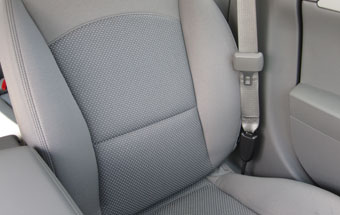
General Motors rolls out a new seatbelt technology aimed at helping select U.S. models reach or retain coveted 5-star safety ratings under stricter testing guidelines from the National Highway Traffic Safety Admin.
GM calls it a Dynamic Locking Latch Plate (DLLP), which allows webbing of the seatbelt to pass through freely and provide the same comfort and convenience of traditional restraint systems.
However, in the event of a crash, the locking plate clamps to prevent transfer of the webbing, holding the lower torso in place and reducing load on the occupant’s chest. It also keeps the legs from impacting the dashboard.
The webbing’s motion across the plate, as the occupant moves forward in the crash, causes it to clamp. The action is entirely mechanical.
“It is a cool little device,” says Larry Kwiecinski, engineering group manager-Vehicle Safety Integration at GM, and “a key enabler” to meeting GM’s crash requirements.
“It helps us control the lower torso in a crash, it keeps the femurs from contacting the instrument panel and it also gives us better tuning and control capability for the upper torso. We can then tune the retractor pretensioners to better interact with the airbags during the crash event.”
Motivation for the technology comes from the stricter 5-star rating system NHTSA is employing for the ’11 model year.

Realizing its 32-year-old New Car Assessment Program had lost some of its teeth because so many new cars and trucks were achieving the highest ratings with relative ease, NHTSA beefed up the standard with tougher testing.
For example, 96% of front- and side-impact crash-tested vehicles in the ’08 model year received four or five stars.
The revamped NCAP still includes criteria for front and side collisions, but now also requires testing for small-stature adults and for neck and femur injuries, as well as chest deflection or crush. It also adds an “oblique pole” crash test against the driver’s side door.
Industry safety experts estimate vehicles once performing at a level earning the highest 5-star rating would receive a 3-star assessment under the new testing, and safety continues to be a key differentiator for auto makers on the dealership floor.
“The rating is very difficult,” says Kwiecinski, whose group designs, engineers and integrates safety technologies into particular vehicle lines at GM. “Very difficult criteria levels (and) five stars are critical in the marketplace.”

The new government rating system put auto makers under a tight deadline. NHTSA announced in 2007 it would add tougher testing, but the final standards were delayed twice. Auto makers found themselves forced to make safety additions to reach or retain the highest ratings, instead of baking them into a product earlier in its development cycle.
“We didn’t have loads of time,” Kwiecinski admits. “We had to act pretty quickly to come with a creative solution.”
Adding knee bags, which are beginning to appear on more vehicles, would have been one logical solution for GM. But it also would have called for a major redesign on some models to accommodate the hardware. So working with its suppliers, the auto maker decided to address its restraint system instead.
GM does not disclose the supplier of the latch system, but Ward’s learns Takata is the provider, along with a new “shock-proof” buckle housing that stays latched better in a crash. Safety experts TRW and AutoLiv also make similar locking plate systems.
The auto maker is not the first to market with DLLP, although it is an early adopter and will drive volume installation of the latch system.
Mechanical pieces inside the DLLP, such as two clamps and a pair of springs, make for a bigger latch housing that is surprisingly hefty to grasp in an era when such units are being downsized. But GM says it has received positive anecdotal feedback, with some customers saying the latch is easier to grab over their shoulder.
During Ward’s 10 Best Interiors testing earlier this year, editors found the latch does insert into the buckle stalk easily and responds with a solid “click” to tell passengers they are buckled up.
The DLLP is not considered a low-cost solution to meeting an auto maker’s crash requirements, industry sources say, but the business case made sense for GM under the tight timetable and given the alternative of an expensive redesign.
“While cost was a consideration, it was more the drive to score well and to provide the safety benefits in a short amount of time, so the solution-set is somewhat limited,” Kwiecinski says. “You can’t redesign the whole vehicle.”
The Chevy Traverse, GMC Acadia and Buick Enclave large cross/utility vehicles, as well as the Chevy Malibu and Impala midsize sedans; Cadillac CTS lineup and SRX; Buick LaCrosse and Regal; and Chevy Equinox and GMC Terrain are among the auto maker’s other models to use DLLP to achieve top scores without knee bags.
The new latch system also appears on the ’10 Saab 9-5 midsize sedan and new-for-’11 9-4X luxury CUV, a pair of products developed while the Swedish auto maker was under GM ownership.
Kwiecinski says GM plans to use DLLP on more vehicles. The decision will be platform-specific and based on how well a particular model performs in crash testing.


